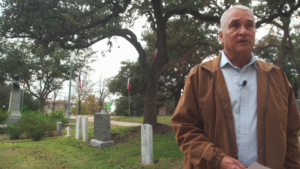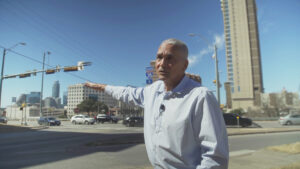Online Courses
On-Location Documentaries Brings “Power and Place” to the Student Experience
Making Texas History Online

What are the stories told about Texas’ history? How do particular places help those stories be told? Dr. Edmund Gordon has built his interdisciplinary course “Power and Place: Making Texas History” around using the built landscape as a window into the state’s history. Gordon has partnered with the Dev Studio to produce on-location documentaries that help familiarize students with the history behind landmarks across Texas.
Gordon’s work with the Dev Studio challenges an oft-cited critique of online learning that it leaves students distant and disconnected from what ought to be engaging content. Gordon has long used visual media in his teaching and has thoroughly enjoyed the opportunity to work with the Dev Studio to produce high-quality short films about Texas sites that convey public history. These documentaries explore the historical narratives promoted by these curated spaces and push students to interrogate how power operates in the making, telling, and remembering of Texas history.

Inspired by the documentary style shows that students might encounter on Netflix or cable, these shorts find Dr. Gordon on location with the historical marker or site. Briefly, he discusses the history of the place and shows the recorded history on the markers. Then he turns to his audience, sometimes seated in the studio and sometimes a student he encounters walking down the street of West Campus. “Do you know where you are?” he asks, and this question, so simple, will catch the student off guard. They think they know where they are, but as Dr. Gordon shows there is always more to learn.
Students thoroughly enjoyed these segments in the Spring AFR 320C course when they first aired. Many viewed these films as a powerful way to translate the murky depths of history into a format that was insightful and engaging. Producing these documentaries help bring to life the debates that have shaped Texas landmarks while making them accessible to a broader array of UT students.